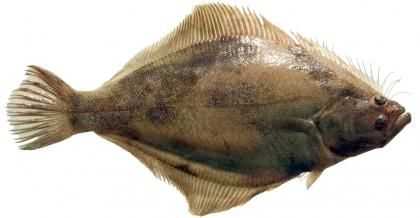California Flounder

Species Details
Paralichthys Californicus
Paralichthyidae
Pleuronectiformes
Inshore, Nearshore
6 - 30 lbs.
54" - 60"
California Flounder (Paralichthys californicus) Description
The California Flounder or the California Halibut is notable for having a tiny head and a well-developed set of large teeth. Like all the other flatfish species, it lies on its side and blends well into the sandy ocean floor as an adult.
A juvenile California Flounder normally starts out with eyes on both sides, and as it matures, its eyes migrate to the other side until it is able to swim on its side upon maturity. Its coloring on its eyed side is typically greenish-brown or greyish, speckled to blend more naturally with the sand or mud, while its “belly” or bottom side is lighter in color, usually white or cream.
Compared to the Pacific Halibut for which it is typically mistaken, the California Flounder is smaller and has a more oval-shaped body. Its dorsal and anal fins are also a little more curved in appearance compared to the Pacific Halibut which has more edgy and triangular fins.
Size & Diet
The California Flounder can grow to at least 60 inches in length and 72 pounds in weight. These fish species are reported to live up to 30 years of age. The California Flounder typically spends most of its time on the seafloor, but it does venture up to feed. When feeding, it can use its camouflaging powers and sharp teeth to attack its prey. It can also actively chase down prey, which is why they can sometimes be seen on the water surface. Its diet typically consists of squids, sardines, and anchovies.
Interesting Facts about the California Flounder
- The California Flounder has the ability to change its coloring to adapt to the color of the seafloor.
- The California Flounder is atypical of flatfishes. Normally, it is considered a left-eyed flatfish, but roughly half of its observed population is also right-eyed.
- This fish species is also an atypical flatfish in that its teeth are quite well-developed and very sharp. Anglers are advised to take caution when handling this fish as it can bite hard.
- The California Flounder is not a particularly migratory fish species. Its young are considered pelagic until they reach 1 year, at which point they begin their journey to the bottom where they will settle as adults.
- When served raw, the California Flounder has a clean taste and buttery texture.
- The California Flounder is also quite easy to prepare and cook as its flesh easily absorbs flavors. It should be cooked with a light touch and must not be overcooked - or else it will become tough to eat.
- Eating a single serving of the California Flounder will satisfy 30 percent of an adult’s recommended daily intake of protein. It is a great source of omega-3 fatty acids, vitamins B-6 and B-12, and potassium.
- The skin only moderately shrinks when cooked, allowing for fillets to be fried or poached without distorting the meat.
Fishing Technique: How to Catch California Flounder
The California Flounder is not a popular game fish as it is not a fighter. A particularly popular method to catch this species is by flounder gigging. This is especially true in Texas. This is done typically at night, when anglers will go on flats-stye boats, aim LED lights at the bottom to prevent the flounder from changing colors and blending with the bottom, then target them with gigs.
Anglers will do well catching them through drift fishing with a light tackle. The best baits for this fish include bull minnows, live squid, sardines, Pacific mackerel, mullet, pinfish, spots, croakers, and shrimp if you’re aiming for a large one.
Using a trap hook is also recommended because some California Flounder will just bite a portion of your bait so you may not be able to hook them. If you’re using a single hook, you may have to wait a few seconds for the flounder to swim away with the bait before you can set it.
Artificial lures will not yield as much success as live bait. However, some anglers have reported moderate success bouncing along with the bottom plastic grubs on jig heads.
The California Flounder can typically be caught on the shores of Southern California. It is available all-year-round, but fishing for them in the late spring during the spawning period is particularly fruitful. While it may not be a big fighter, it can make quite a scene once on the boat. Anglers are also advised to handle it with care as its teeth are particularly sharp.
Habitat and Distribution
The California Flounder occurs in the waters of Magdalena Bay, Baja California, Mexico up to Quillayute River, British Columbia. It can also be found in the upper Gulf of California. A majority of its population also occurs in the southern part of San Francisco.
It is a demersal fish species at adulthood, preferring to stay in sandy sediments. It congregates and spawns on bays and estuaries. Juveniles are found settling in nurseries where they are born. Male juveniles swim towards the open coast upon maturity at 2 to 3 years. Females are much larger when they migrate towards the coast. Some of these fish species can be found near the surf zone up to 330 feet but most are typically found 100 feet away.







